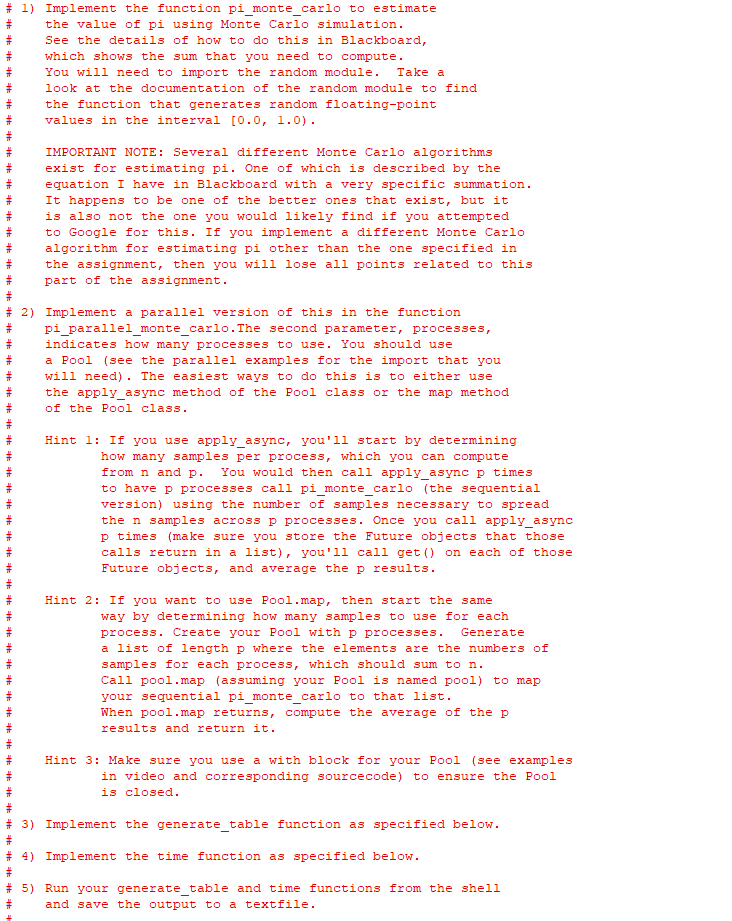Follow the instructions in the screenshots provided carefully to implement the code below in python 3.10 or later, please. def pi_monte_carlo(n) : """Computes and returns an estimation of pi using Monte Carlo simulation. Keyword arguments: n - The number of samples. """ pass def pi_parallel_monte_carlo(n, p=4) : """Computes and returns an estimation of pi using a parallel Monte Carlo simulation. Keyword arguments: n - The total number of samples. p - The number of processes to use. """ # You can distribute the work across p # processes by having each process # call the sequential version, where # those calls divide the n samples across # the p calls. # Once those calls return, simply average # the p partial results and return that average. pass def generate_table() : """This function should generate and print a table of results to demonstrate that both versions compute increasingly accurate estimations of pi as n is increased. It should use the following values of n = {12, 24, 48, ..., 12582912}. That is, the first value of n is 12, and then each subsequent n is 2 times the previous. The reason for starting at 12 is so that n is always divisible by 1, 2, 3, and 4. The first column should be n, the second column should be the result of calling piMonteCarlo(n), and you should then have 4 more columns for the parallel version, but with 1, 2, 3, and 4 processes in the Pool.""" pass def time() : """This function should generate a table of runtimes using timeit. Use the same columns and values of n as in the generate_table() function. When you use timeit for this, pass number=1 (because the high n values will be slow).""" pass
Follow the instructions in the screenshots provided carefully to implement the code below in python 3.10 or later, please.
def pi_monte_carlo(n) :
"""Computes and returns an estimation of pi
using Monte Carlo simulation.
Keyword arguments:
n - The number of samples.
"""
pass
def pi_parallel_monte_carlo(n, p=4) :
"""Computes and returns an estimation of pi
using a parallel Monte Carlo simulation.
Keyword arguments:
n - The total number of samples.
p - The number of processes to use.
"""
# You can distribute the work across p
# processes by having each process
# call the sequential version, where
# those calls divide the n samples across
# the p calls.
# Once those calls return, simply average
# the p partial results and return that average.
pass
def generate_table() :
"""This function should generate and print a table
of results to demonstrate that both versions
compute increasingly accurate estimations of pi
as n is increased. It should use the following
values of n = {12, 24, 48, ..., 12582912}. That is,
the first value of n is 12, and then each subsequent
n is 2 times the previous. The reason for starting at 12
is so that n is always divisible by 1, 2, 3, and 4.
The first
column should be n, the second column should
be the result of calling piMonteCarlo(n), and you
should then have 4 more columns for the parallel
version, but with 1, 2, 3, and 4 processes in the Pool."""
pass
def time() :
"""This function should generate a table of runtimes
using timeit. Use the same columns and values of
n as in the generate_table() function. When you use timeit
for this, pass number=1 (because the high n values will be slow)."""
pass


Trending now
This is a popular solution!
Step by step
Solved in 4 steps with 2 images

How do I get this code to output the data into a text file?








